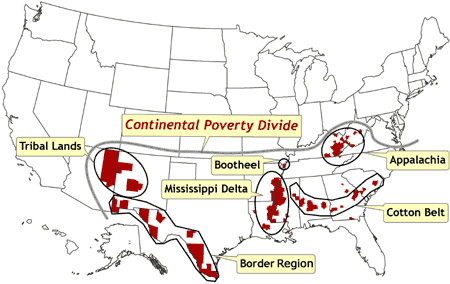 Director Lisa Biagiotti
spent two years travelling around the South
interviewing people about AIDS to make a film,
deepsouth.
She found rural AIDS is a bigger and faster-growing problem
than AIDS in center cities,
yet most health and prevention funding goes to urban areas.
The root cause seemed clear to her: poverty.
Here’s some deeper dirt (literally) on rural poverty in the U.S.,
and one thing we know can help with that: distributed solar power,
for jobs, for reduced electrical bills, and for energy independence.
What politician wouldn’t want jobs for their constituents?
Director Lisa Biagiotti
spent two years travelling around the South
interviewing people about AIDS to make a film,
deepsouth.
She found rural AIDS is a bigger and faster-growing problem
than AIDS in center cities,
yet most health and prevention funding goes to urban areas.
The root cause seemed clear to her: poverty.
Here’s some deeper dirt (literally) on rural poverty in the U.S.,
and one thing we know can help with that: distributed solar power,
for jobs, for reduced electrical bills, and for energy independence.
What politician wouldn’t want jobs for their constituents?
The director said the screening at VSU at the end of November drew more people than the day before in Little Rock. There were clearly more than 150 in the audience in Valdosta. It’s a topic very relevant to here, as Dean Poling wrote in the VDT 26 November 2012,
Organizers note that Georgia is ranked sixth highest nationally for its cumulative number of AIDS cases reported through December 2009. More than 40,000 known HIV/AIDS cases were reported in Georgia as of 2010.
The South Health District’s 10 counties, which include Lowndes and
surrounding counties, report 950 confirmed cases of HIV/AIDS, while many more are likely infected and risk becoming sick because they are not being treated. More specifically, there are about 460 reported cases in Lowndes County.
In reporting these numbers, HIV is the virus (HIV disease) and AIDS is the medical diagnosis made by a doctor of the symptoms, according to South Health District.
It’s a great movie and I highly recommend it. Director Biagiotti spent a substantial amount of her own money and two years to make this film, yet there are aspects she could only note in passing, such as incarceration. She can’t be expected to have researched every aspect; maybe somebody else can step up and help follow more threads.
The movie starts with some maps about poverty and AIDS in the South. It did not, however, look outside the South for poverty. Here are better poverty maps, from the CDC:
Continue reading